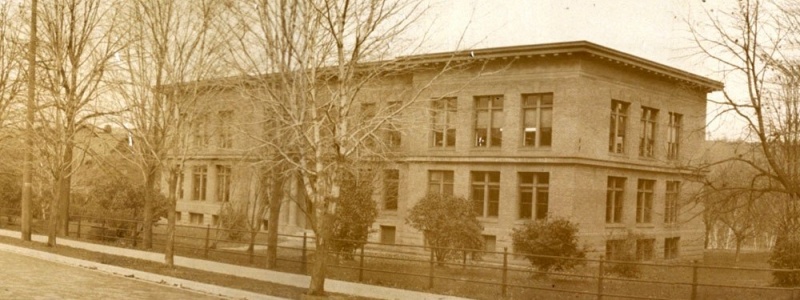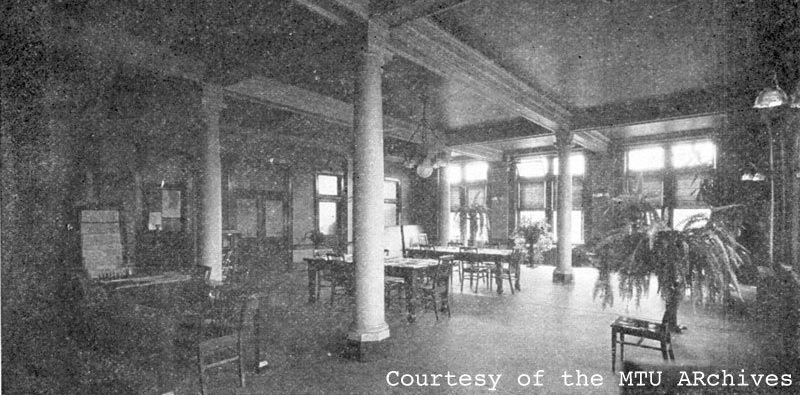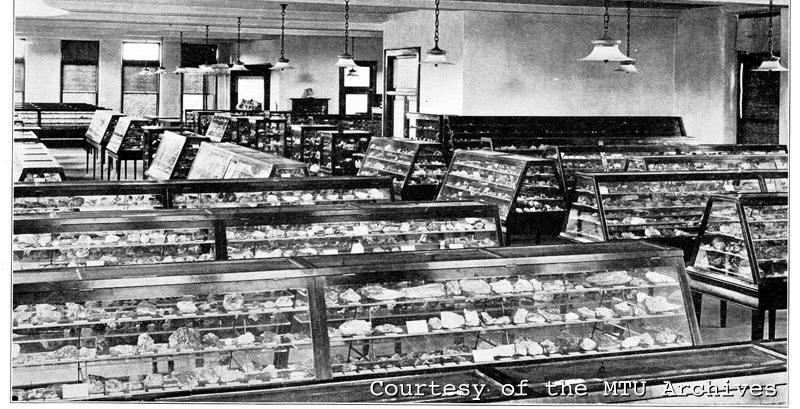As part of the 1906 campus expansion, the AOB was designed by Charlton & Kuenzli Architects of Marquette to house the University’s administrative offices, the library, and a mineral museum. Although the Panic of 1907 shrank enrollment in colleges across the state (and country) through 1912, the AOB opened its doors for the fall term in 1909 and served as the main administration and library building for the campus until the mid-1960s. By the early 1930s, the mineral museum had moved out, and the AOB became simply the “Admin and Library Building.” After the new library opened in 1965 and the new administration building in 1968, the AOB became home to various academic departments.
In 1909, the University enrolled nearly 300 students and the existing two-room library on the second floor of Hubbell Hall was unable to accommodate this influx. The new library, which occupied the ground floor of the west half of the building, had a main reading room with space for 90 patrons. When you entered the AOB, three steps on the left-hand side of the foyer descended into the library’s reading room, where you would find the circulation desk on your right and the periodical room on your left (now AOB 107). The three-level wing at the rear of the building was built for library shelving that would accommodate 50,000 volumes (though it held nearly 58,000 by 1958 and 65,000 by 1963), and the main reading room held the special collections, consisting of the 60 or so books of the Longyear Spitsbergen collection and a collection of about 100 rare technical works from the 16th to the 18th century.
The University’s administration occupied seven small rooms in the eastern half of the first floor. The president’s office was in the northeast corner (now the dean’s office of the School of Business and Economics). Also situated on the first floor were the offices of the treasurer and registrar, which flanked a file room—accessible only from the treasurer's office—that contained a staircase descending to the University's vault. The basement held a mixture of small offices, the shipping room, the library’s newspaper stacks, the University printer, and the ROTC offices, supply room, and rifle racks. It also held a “girls’ lounge” through at least World War II for the small number of female students at the University.
The entire second floor of the AOB was dedicated to the “Mineralogical and Specimen Museum”—to house local and international rock specimens. It was designed as a 44-by-127-foot, open-plan room with 12-foot ceilings, featuring an enclosure at the head of the stairwell and a small preparation room in the northwest corner. The mineral collection was begun in 1899 by professors A. E. Seaman and G. A. Koenig and the mining geologist L. L. Hubbard (then foreman of the Champion mine). By 1932, the mineral museum moved into Hotchkiss Hall, and the second floor was divided into a faculty lounge (including a faculty game room with billiards table), faculty offices, and classrooms. For a short time after World War II, the second floor housed the president’s office (AOB 208) before the administration moved to its new building in the late 1960s. At that same time, the rear (northern wing) of the AOB was remodeled into faculty offices, with the only remnants of its beginnings as the original library’s stacks section being the single iron staircase and relatively low ceilings.


